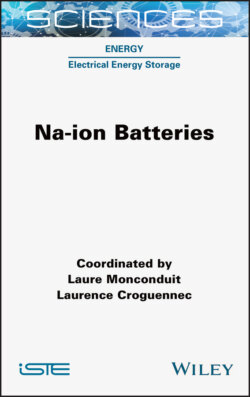Читать книгу Na-ion Batteries - Laure Monconduit - Страница 37
1.4.3. P2-Na2/3[Mn,Fe,M]O2
ОглавлениеA solid solution of P2-Na2/3[Mn,Fe]O2 was also synthesized and the battery performances were investigated in Li cells in the early 2000s (Eriksson et al. 2003; Matsumura et al. 2003). Our group evaluated Na (de)intercalation properties of P2-Na2/3Fe1/2Mn1/2O2 and P2-Na2/3Fe1/2Mn1/2O2 deliver a reversible capacity of ca. 190 mAh g−1 and exhibit good rate performance in Na cells in the range of 1.5–4.3 V (Yabuuchi et al. 2012a), as shown in Figure 1.14. P2-Na2/3Fe1/2Mn1/2O2 consists only of the abundant elements in the Earth’s crust without cobalt and shows acceptable capacity retention different from O3-NaFeO2, which is probably due to less or reversible Fe migration into interslab space. The P2-Na2/3Fe1/2Mn1/2O2 phase transforms into an OP4-like phase by Na extraction on charge to 4.3 V and tetrahedral sites exist in the O-type interslab space. P2-Na2/3Fe1/2Mn1/2O2 shows capacity decay during cycles, which is thought to be caused by irreversible migration of transition metals into the interslab space. Talaie et al. successfully detected migrated transition metals at tetrahedral sites in the interslab space by pair distribution function (PDF) analysis on the XRD patterns of chemically oxidized Na0.1Fe1/2Mn1/2O2, Na0.15Fe1/2Mn1/2O2, Na0.15Fe0.3Mn0.6Ni0.1O2, Na0.15Fe0.2Mn0.65Ni0.15O2 and Na0.1Fe0.2Mn0.66Cu0.14O2 (Talaie et al. 2015, 2017). The amount of Fe migration is higher in NaxFe1/2Mn1/2O2 than in Cu and Ni doped materials. Indeed, cycling stability of the doped samples is better than that of P2-Na2/3Fe1/2Mn1/2O2. The P2-Na2/3Fe1/2Mn1/2O2 sample, however, generally contains crystal domains of O3-NaFe1/2Mn1/2O2, leading to broad 10l Bragg diffraction peaks in the XRD (Yabuuchi et al. 2012a). The difficulty of synthesizing pure P2-Na2/3Fe1/2Mn1/2O2 complicates our understanding of the reaction mechanism. As Talaie et al. also mentioned in the literature, reversible charge–discharge behaviors are observed for P2-type materials in Na cells even if transition metals are migrating to interslab space, which is quite different from O3-NaFeO2 and O3-NaCrO2 (Figure 1.8). Mortemard de Boisse et al. (2014) confirmed well-crystallized phases and no significant structural evolution before and after sodium extraction/insertion for P2-NaxFe1/2Mn1/2O2. Except for the capacity decay, P2-Na2/3Fe1/2Mn1/2O2 has some drawbacks: (1) voltage hysteresis in between charge and discharge as seen above 3 V in Figure 1.14, (2) Na deficiency in the as-prepared state and (3) hygroscopic property like O3-type materials. First, the significant voltage hysteresis appears after charging beyond 4.1 V (Talaie et al.
2015). Despite extensive research, the mechanism of the voltage hysteresis has not been elucidated yet. Redox reaction of oxide ion (Talaie et al. 2015) and P2/OP4-like phase transition accompanied by formation of stacking faults (Mortemard de Boisse et al. 2014) and by migration of transition metals (Talaie et al. 2015) are estimated to cause the voltage hysteresis. Second, Na deficiency is a considerable issue in all P2-type materials showing capacity below 2.5 V and the large reversible capacity is achieved by Na compensation from external Na sources such as Na metal counter electrode in a half-cell and pretreatment with Na metal by ball milling (Zhang et al. 2016), but Na metal should be avoided in the Na-ion battery full cells and synthesis process due to safety issues. Recently, the addition of sacrificial Na sources such as NaN3 and Na2CO3 is proposed to compensate for Na in the full cells without Na metal (Singh et al. 2013; Martinez De Ilarduya et al. 2017; Sathiya et al. 2017). Third, as discussed in the hygroscopic property of O3-type materials above, P2-type materials are also generally hygroscopic except for P2-Na2/3Ni1/3-xCuxMn2/3O2 (0 ≤ x ≤ 1) (Lu and Dahn 2001b; Zheng et al. 2017). Air stable P2-Na2/3[Mn,Fe]O2 is achieved by Cu doping (Li et al. 2015; Talaie et al. 2017). Doping with Cu2+ and alkaline earth metals would be effective to enhance the waterand moisture-resistant properties of P2-type materials. Ternary and quaternary Fe–Mn-based P2-type materials such as P2-Nax[Fe,Mn,Ti]O2 (Han et al. 2016), P2-Nax[Fe,Mn,Co]O2 (Thorne et al. 2014b), P2-Nax[Fe,Mn,Ni]O2 (Talaie et al. 2015; Bai et al. 2016), P2-Nax[Fe,Mn,Co,Ni]O2 (Kaithwas and Kundu 2015; Li et al. 2017) and P2-Nax[Fe,Mn,Cu]O2 (Li et al. 2015; Talaie et al. 2017) have also been extensively studied and Fe in P2-type materials would also assist Na diffusion at the end of charge due to the flexibility of Jahn–Teller active Fe4+ (Liu et al. 2015) as observed in O3-type materials (Li et al. 2016). The metal doping in P2-Nax[Mn,Fe]O2 suppresses the voltage hysteresis, but the Na compensation and raising working voltage are challenging.
